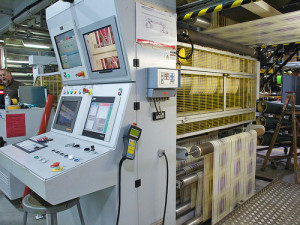 Flexographic printing is a relatively new name for a pretty old process. Since the 1990s there have been lots of advances in the technology we use in flexographic printing but the history of the process goes back pretty far in the history of printing for consumer goods.
Flexographic printing is a relatively new name for a pretty old process. Since the 1990s there have been lots of advances in the technology we use in flexographic printing but the history of the process goes back pretty far in the history of printing for consumer goods.
Originally named aniline printing, it was invented in the early 1900s in Germany. Rubber plates on rollers pick up inks and then transfer that ink onto the printing surface. Printers found that it works very well on non-porous surfaces, like plastics, cellophane, papers, and even metal. Because full color printing is easy with aniline printing, many food packaging companies used the process for their boxes. But in the 1940s the USDA decided that aniline inks were not safe for use on food packaging.
Although the industry adapted to the new USDA requirements and used new inks that didn’t pose health risks, packaging companies were fearful of using the process—no one wants to get slapped with getting shut down by the USDA because of packaging, after all. One company, the Mosstype Corporation, wanted to change that. Business was suffering so they decided to rebrand the printing process to bring in more customers.
The then president, Franklin Moss, sent out a survey in Mosstyper, the Corporation’s industry magazine, and asked other printers for possible names. After assembling over 200 names, the Packaging Insitute got a subcommittee together to decide on a name. The choices were narrowed down and another survey was sent out with three choices: “permatone process”, “rotopake process”, and “flexographic process.” The ballots were overwhelmingly in favor of flexographic and a “new” brand was born.
Although there have been many changes along the way, from the inks used to the mechanical processes, one thing remains the same—it’s all about rolling. Without a servomotor that’s reliable to roll consistently time after time, flexographic printing becomes misaligned and colors don’t match up. If you’ve ever had a box of cereal where some colors were misplaced, that’s because the rollers weren’t working correctly.
We have helped printers across the country get their servomotors working in proper order to ensure that colors are always perfect. If your Rexroth or Indramat servos aren’t working properly, give us a call. We can usually troubleshoot over the phone and we also can fly out to resolve your problem if it needs our hands-on expertise.
